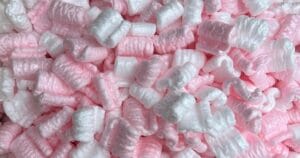On Friday, we finally caught up with the pre-orders for the reprints of Volume 1 of the True book collection. One recipient complained: “I was bummed that my books came packaged with Styrofoam ‘peanuts’. I can’t believe that any world-conscious business would buy those dang things and pollute our planet! Can’t you use something else? There is a new product out that uses recycled newspapers, for instance.”
Actually, we don’t buy them, and I’m happy to say we never have. Instead, we first buy packaging that reduces our need for packing material by being the “right size” for most orders. Second, rather than buy “peanuts,” we reuse those which come here in other packages, and collect them from friends so they’re not thrown away. (“Reduce” and “Reuse” being, in my opinion, even more important than “Recycle”!)
 We have indeed looked at the recycled newspaper pellets, but they are too hard for softcover books (they appear likely to mar the covers), and looked rather “dirty” to me — likely to rub some of their embedded ink onto the white page edges. I figure that when you order new books, they should arrive looking like new books.
We have indeed looked at the recycled newspaper pellets, but they are too hard for softcover books (they appear likely to mar the covers), and looked rather “dirty” to me — likely to rub some of their embedded ink onto the white page edges. I figure that when you order new books, they should arrive looking like new books.
As far as being “world-conscious,” starting with the first True volume to go to press in 1995, we’ve required the book printers to use non-petroleum-based inks and print on acid-free paper. It’s a small thing, but small things add up — especially when we tell printers that they didn’t get the job because they couldn’t meet those demands.
So there!
– – –
I never did buy any the things. We no longer ship books: most want ebooks today, but if they really want paper they’re printed on demand.

Kudos to you for reducing and reusing — those concepts get us a lot further ahead than focusing primarily on recycling (which tends to get the bulk of public attention!)
Are you familiar with the Forest Stewardship Council paper and printing certification system? It’s an international certification standard that guarantees that the paper you use is either from trees harvested in the most environmentally friendly way possible, or 100% recycled, or both. You can find printers and paper FSC-certified in the United States.
FSC was developed by environmental groups and industry working together, unlike any of the other forestry certification systems around, which are all industry-driven. It applies to both lumber and paper production. It’s a tough, fair process, with extensive community and ENGO involvement in judging a company’s application for certification.
I appreciate reduce and reuse more now that I know someone who works as a garbageman. The city he works for has a recycle program, but when they have a very busy day they mix the recycles with garbage and take it all to the dump.
Aha! Another confirmation of my Theory of Peanut Conservation. There are a constant number of packing peanuts in the universe, people just keep shipping them back and forth to each other. It’s similar to the Constant Christmas Fruitcake theory. 🙂
Packing peanuts… I always called it styrofoam popcorn. My company had loaned an expensive ($5,000) lens to a movie theater for evaluation one time. When they were going to ship it back, they called to ask how to safely pack such a valuable item. I responded that they could just put it in a regular cardboard box and make sure it was well insulated by popcorn.
Bad thing to say to a movie theater. I received a substantially large boxful of buttered popcorn, in the middle of which was my lens.
—
Ewww — greasy! I suppose the stuff used to be made from styrofoam, but it isn’t (ever?) anymore. Some of it is even made of cornstarch, so it breaks down well in the environment. Either way, I’ve been accumulating it, since I have a fun new GOOHF product in the works, and it will need filler in the box…. -rc